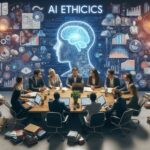The AI opportunities for 2023 and the next Decade: A Deep Dive into the AI Landscape
In recent years, artificial intelligence (AI) has been likened to the new electricity—a transformative force with the potential to revolutionize various industries. The excitement and hype surrounding AI are palpable, but understanding the true breadth of its applications can be challenging. Just as electricity powers a multitude of devices and processes, AI serves as a general-purpose technology, offering countless possibilities across various domains.
Artificial Intelligence (AI) has become the “new electricity” of our digital era, a general-purpose technology with boundless applications. In a recent presentation by Andrew Ng, a leading AI expert, he shed light on the transformative potential of AI, particularly focusing on supervised learning and generative AI. This blog post delves into the key takeaways from his presentation, outlining the opportunities and trends in AI and how they are shaping our world. we’ll explore the AI landscape, discuss the key tools and opportunities it presents, and delve into the fascinating world of AI startups.
AI as a Collection of Tools:
At its core, AI is a collection of tools, each tailored for specific tasks. Two of the most prominent tools in the AI toolbox are supervised learning and generative AI. AI: A Collection of Tools
At its core, AI can be viewed as a collection of tools. Two of the most important tools in the AI landscape today are supervised learning and generative AI. Supervised learning excels in recognizing and labeling data, making it invaluable in tasks such as spam detection in emails, personalized advertising, self-driving cars, and automated visual inspections in factories. The power of supervised learning lies in its versatility across various applications.
- Supervised Learning: This technique excels at labeling or classifying data. It’s like teaching a computer to recognize patterns and make predictions. Examples of its applications include spam email filters, online advertising, self-driving cars, and more. The power of supervised learning lies in its versatility, making it applicable to a wide array of real-world problems.
- Generative AI: A more recent and exciting development, generative AI allows machines to create new content based on existing data. For instance, models like ChatGPT can generate coherent text based on a given prompt. This opens up numerous creative possibilities, from content generation to personalized recommendations.
Supervised Learning Workflow
The workflow of a supervised learning project involves gathering labeled data, training an AI model to learn from this data, and deploying the trained model to make predictions. The past decade witnessed significant advancements in large-scale supervised learning, demonstrating that as models grow in size and are exposed to more data, their performance continues to improve. This has been the driving force behind many AI breakthroughs.
The Last Decade:
Large-Scale Supervised Learning Over the past decade, large-scale supervised learning has been a dominant force in AI. The key insight here is that bigger AI models trained on more data tend to perform better. This led to the development of massive neural networks, fueled by powerful GPUs, and it significantly contributed to AI progress.
Generative AI:
The Decade Ahead The current decade promises to continue the momentum of supervised learning while adding generative AI to the mix. Generative AI, with its text and content generation capabilities, has captured the imagination of developers and entrepreneurs alike. With the likes of ChatGPT and similar models, the possibilities seem limitless.
Generative AI: The New Frontier
Generative AI, on the other hand, is an exciting development in the AI landscape. It focuses on creating content or generating responses based on given prompts. A notable example is ChatGPT, which can generate coherent text based on a few words or phrases. Generative AI relies on supervised learning, where the AI system predicts the next word in a sentence. When trained on vast amounts of text data, it can produce remarkable results.
AI Opportunities: Where’s the Value?
In assessing the value of AI technologies today, supervised learning dominates, generating substantial financial value, especially in consumer software and the internet industry. However, generative AI is rapidly gaining ground, attracting significant interest from developers, investors, and corporations. The potential for generative AI to double or even triple in value in the next three years is undeniable. This growth trajectory is poised to create a wealth of opportunities for both startups and established companies.
AI as a General Purpose Technology
One crucial aspect to understand about AI is that it is a general-purpose technology. Like electricity, AI can be applied across diverse domains, opening the door to countless possibilities. While we have made significant strides in harnessing supervised learning and generative AI, there is still a vast landscape of untapped potential waiting to be explored. The sheer diversity of use cases makes AI a promising field for innovation.
The Key to Widening AI Adoption
Despite the buzz surrounding AI, its adoption remains concentrated in the consumer software and internet sectors. To expand its reach, we need to address the high cost of customization and the limited availability of AI expertise. The emergence of low-code and no-code tools is a significant step in the right direction. These tools empower individuals and organizations to customize AI solutions for their specific needs, reducing the barrier to entry for various industries.
AI Stack: Where to Play?
In the AI ecosystem, several layers offer distinct opportunities. The hardware and infrastructure layers are capital-intensive and typically favor larger players. The developer tool layer, while competitive, presents opportunities for startups to carve out their niche. However, the real potential lies in the application layer. Here, subject matter expertise combined with AI capabilities can lead to groundbreaking solutions.
Building Startups with Concrete Ideas
One approach to building successful startups in the AI space is to start with concrete ideas. While design thinking emphasizes exploration and ideation, the efficiency of AI development often requires a well-defined starting point. Concrete ideas are easier to validate, provide clear direction for execution, and facilitate collaboration with subject matter experts. Startups built on such ideas can rapidly move from ideation to validation, increasing their chances of success.
AI is reshaping industries and unlocking new possibilities across the board. From supervised learning to generative AI, the tools at our disposal are more potent than ever. The key to widening AI adoption lies in democratizing its use through accessible tools and embracing the wealth of opportunities in diverse industries. As we continue to explore the potential of AI, one thing is clear: the journey has just begun, and the future is AI-powered. The transformational power of AI is not limited to a single domain or application; it is a force that will shape our world in countless ways. Whether you’re a startup founder, a developer, or an industry expert, there has never been a better time to harness the potential of AI and embark on a journey of innovation and discovery.


